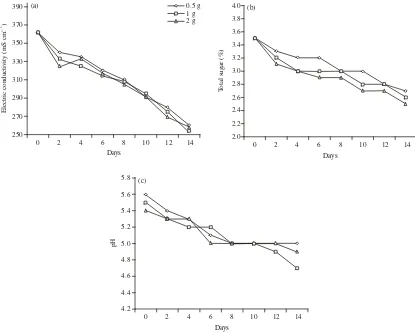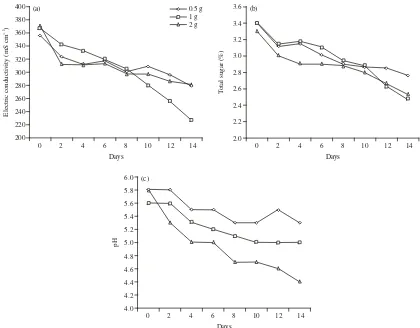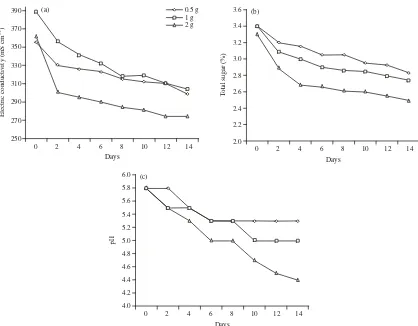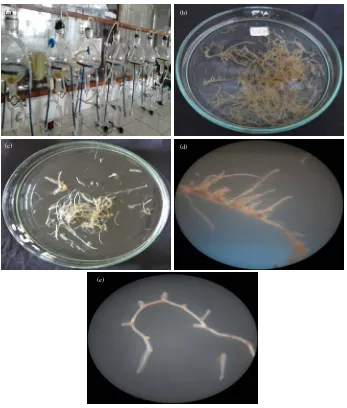Asian Journal of Biological Sciences 8 (2): 83-92, 2015 ISSN 1996-3351 / DOI: 10.3923/ajbs.2015.83.92 © 2015 Knowledgia Review, Malaysia
Optimization of Culture Conditions of
Talinum paniculatum
Gaertn.
Adventitious Roots in Balloon Type Bubble Bioreactor Using
Aeration Rate and Initial Inoculum Density
1
Y.S.W. Manuhara,
2A.N. Kristanti and
1E.S.W. Utami
1
Department of Biology, Faculty of Science and Technology, Airlangga University, Surabaya, 60115, Indonesia
2
Department of Chemistry, Faculty of Science and Technology, Airlangga University, Surabaya, 60115, Indonesia
Corresponding Author: Y.S.W. Manuhara, Department of Biology, Faculty of Science and Technology, Airlangga University, Surabaya, 60115, Indonesia
ABSTRACT
Optimization of culture conditions of Talinum paniculatum Gaertn. adventitious roots in the balloon type bubble bioreactor have been done in order to increase its production of adventitious roots and saponin content. Culture conditions were used in this research were combination of aeration rate (0.25, 0.5 and 0.75 vvm) and initial inoculum density (0.5, 1, 2 g/400 mL). Bioreactor with a volume of 1000 mL was filled with 400 mL of liquid MS medium supplemented with IBA 2 mg LG1 were then given sterile air through a microfilter (0.2 µm) with different air flow rates. Into
each bioreactor were added of different inoculum density of adventitious roots that had previously been induced from leaf explants of T. paniculatum on solid MS medium supplemented with IBA 2 mg LG1. Cultures were maintained for 14 days and sampling was done for every two days to
determine the sugar content, conductivity and pH of the medium. The results showed that the combination of aeration rate of 0.5 vvm and inoculum density of 1 g/400 mL was the best treatment that can increase biomass of adventitious roots, whereas the combination of aeration rate of 0.75 vvm and inoculum density of 2 g/400 mL was the best treatment that can be increased of saponin content.
Key words: Talinum panicultum Gaertn., adventitious root, balloon type bubble bioreactor,
liquid culture, saponin
INTRODUCTION
100 g of roots per plant. In addition, it is known that levels of saponins of java ginseng root age of 3 months was lower than the java ginseng roots grown in vitro for 28 days. Because of the necessary compounds in T. paniculatum was accumulated in root organ, the root culture technology is essential for the preservation of these plants developed in order to awake and efficacious compounds, especially saponin compounds that was accumulated in the root organs can be improved.
In many decades, adventitious root cultures have been used to produce many kind of secondary metabolites which have naturally in root. The advantages of adventitious root culture are the root not influenced by geotropism, growth of root branch fast and had a genetic stability. Many researches have been conducted to increase biomass and secondary metabolite by adventitious roots in bioreactor, for examples, producing whitanolide-A in adventitious root of Whitania somnifera (Praveen and Murthy, 2010; Sivanandhan et al., 2012), increasing biomass and secondary metabolite of Glycyrrhiza uralensis Fisch (Yin et al., 2014), increasing bioreactor capacity to produce biomass and cafeic acid derivatives in adventitious root culture of Echinacea angustifolia (Cui et al., 2013), production of adventitious root biomass of Podophyllum hexandrum Royle (Rajesh et al., 2014), Astragalus membranaceus (Wu et al., 2011), Stevia reboudiana Bertoni (Reis et al., 2011) and Panax ginseng (Wang et al., 2013).
Inducing the formation of adventitious roots of T. paniculatum using hypocotyls, epicotyls and leaves explants have been succeeded in solid and semisolid MS (Murashige and Skoog, 1962) medium supplemented with IBA 2 mg LG1. But the growth in semi-solid media is limited by the
availability of oxygen and culture space. This can be overcome by moving it into a liquid medium in a larger vessel such as flasks or bioreactors. Some of the advantages of liquid culture method in the bioreactor is oxygen demand that can be done by agitation or aeration, the culture space limitations can be overcome by using of the flask or bioreactor and nutrients can be accessed by all parts of the organ cultured. But growth in the bioreactor is influenced by many factors, such as shear stress, oxygen supply and gas composition (Kanokwaree and Doran, 1997).
Gas exchange between the gas and liquid phase is one of the factors that influence the cell and organ culture of plants in a liquid medium. In the bioreactor, strong aeration necessary for the supply of dissolved oxygen and increase the homogeneity of the liquid. Lee et al. (1998) reported that the concentration of dissolved oxygen through the aeration was beneficial for root growth and alkaloid production (tropan) in roots cultured of Atropa belladonna. In addition to aeration, inoculum density was also reported to affect the performance of cell suspension cultures and increased production of secondary metabolites. If the initial inoculum density was low, the cell growth was also low (Kanokwaree and Doran, 1997). But, if the initial inoculum density is high, the lag phase in cell culture does not occur because of the direct growth to be in the exponential phase. This suggests that increased secondary metabolites along with increased number of cells (Van Gulik et al., 1994; Sakurai et al., 1996). So, this experiment was conducted to optimization of the culture conditions of T. paniculatum Gaertn. adventitious roots in balloon type bubble bioreactor with the treatment of various aeration rate dan initial inoculum density.
MATERIALS AND METHODS
Materials: Talinum paniculatum Gaertn. was obtained from the Botanical Garden Purwodadi,
Asian J. Biol. Sci., 8 (2): 83-92, 2015
Induction and proliferation of adventitious roots: Leaves were washed with detergent and
then rinsed thoroughly with tap water. Explants were sterilized with clorox 10% (v/v) and soaked for 10 min while gently agitated. After that, clorox solution discarded and rinse 3 times with sterile distilled water. Explants were placed in sterile filter paper in the petridishes and cut 1 cm2 and
then planted in MS medium supplemented with IBA 2 mg LG1, 30 g LG1 sucrose and 7 g LG1 agar.
Cultures were maintained in room culture at 25°C in the dark conditions. After 4 weeks, adventitious root were used for the next stage.
Adventitious root culture in balloon type bubble bioreactor: Adventitious roots obtained
from the previous stage were used as inoculum. Balloon Type Bubble Bioreactor (BTBB) was designed by Gupta and Ibaraki (2008). Bioreactor with a capacity of 1 L was filled with 0.4 L of liquid MS medium supplemented with IBA 2 mg LG1, 30 g LG1 sucrose and sterilized by autoclaving
at 121°C for 20 min. The experiment consisted of 9 cultures that received the combinations of treatment aeration rate: 0.25, 0.5 and 0.75 vvm (volumes of gas per volume of liquid per minute) and the initial inoculum density: 0.5, 1.0 and 2 g/400 mL. The cultures were incubated at room temperature for 14 days and each treatment has 3 replications. Fresh weight and dry weight of adventitious roots and saponin content were analyzed at the end of the cultivation period. To determine the growth of adventitious roots, pH, total sugar content and conductivity of the medium were done. Measurements were done every two days by taking 1 mL of culture medium. Measurement of pH was done using a pH meter (Boeco, BT-600), the total sugar content was measured using a hand refractometer (Atago), while the conductivity was measured using conductometer (Ezdo, Cond5021).
Extraction and analysis of saponins: Saponins contained in adventitious roots were analyzed
qualitatively using thin layer chromatography and quantitatively using HPLC. Adventitious roots were dried at 50°C for 5 days and then were grinded used mortar. A 100 mg powder of adventitious roots were immersed in 10 mL of ethanol and then heated 80°C in water bath for 30 min. The extract was then concentrated in 80°C for 3 h until a volume of 0.2 mL was obtained. Extracts and saponins standard (Calbiochem) were spotted on silica gel GF254 and eluted using propanol: water (14:3). Spot were detected by spraying with a mixture of anisaldehyde 0.5 mL, acetic acid glacial 10 mL, ethanol 85 mL, sulfuric acid 5 mL and then heated at 110°C for 6-10 min. Saponin standard gave the dark green colour. Quantitatively measurement of saponin was done using HPLC system (Agilent Q-TOF 6530 L) equipped with c18 columns. The mobile phase was a mixture of reagent 0.1% formic acid in water grade and acetonitrile (40:60, v/v) and the volume inject were 0.2 µL. The detection wavelength was set at 299 nm.
RESULTS
Effect of combinations of treatment of initial inoculum density and aeration rate on
adventitious root biomass: Combinations of treatment of initial inoculum density and aeration
rate affect the growth of adventitious roots. Growth ratio of adventitious root indicated by root fresh weight at the end of the culture reduced the initial fresh weight (Fig. 1).
0.422
Fig. 1: Growth ratio of adventitious roots on combination of aeration rate and initial inoculum density on 14 days culture
Asian J. Biol. Sci., 8 (2): 83-92, 2015 of T. paniculatum in balloon-type bubble bioreactor with combination of aeration rate (0.5 vvm) and initial inoculum density 0.5, 1 and 2 g/400 mL
Combination of treatment aeration rate 0.5 vvm and initial inoculum density 0,5 1 and 2 g have highest biomass at the treatment of 0.5 vvm and 1 g. Growth of the adventitious roots in that treatment were support of the medium condition include the conductivity, total sugar and pH medium during culture (Fig. 3). Final conductivity at the combinations of treatment 0.5 vvm and 1 g/400 mL was lower than two other combinations of treatment. It was indicate the maximum absorption of nutrient from medium. The same condition also happen in the absorption of sugar which were showed of concentration of total sugar at 14 days also lowest, whereas pH medium during culture were constant at 5-5.3. This condition induced the growth of adventitious root cells, so the biomass of adventitious root increased.
Combinations of treatment aeration rate 0.75 vvm and initial inoculum density 0.5, 1, 2 g/400 mL showed the negative growth at treatment 0.75 vvm and 0.5 g (Fig. 2). It was seen from the data of conductivity, total sugar and pH medium showed that condition not different with another treatment (Fig. 4). At the combination of aeration rate 0.75 vvm and initial inoculum density 1 g/400 mL and 2 g mLG1 have a positive growth, same as aeration rate 0.25 and 0.5 vvm,
Days
Fig. 4(a-c): (a) Conductivity, (b) Total sugar and (c) pH medium of adventitious root culture of T. paniculatum in balloon-type bauble bioreactor with combination of aeration rate (0.75 vvm) and initial inoculum density 0.5, 1 and 2 (g mLG1)
growth of root branch were rare, it can be seen in Fig. 5c and e. But at the combinations of treatment aeration rate 0.5 vvm and initial inoculum density 1 g/400 mL were the best condition of culture. It was indicated by highest of biomass and growth of root branches much more than other combinations of treatment (Fig. 5b and d). At the aeration rate 0.75 vvm adventitious root culture will get the shear stress caused by produce of size and number of bubble. When aeration rate increase, produce of bubble will be increased, so it can inhibit the growth of adventitious root. It also happened in hairy root culture of T. panicultum which got the shear stress in treatment of aeration rate 0.75 vvm (Manuhara et al., 2012).
Effect of combinations of treatment of initial inoculum density and aeration rate on
saponin content of adventitious root: Qualitative analyzed of saponin at adventitious root
Asian J. Biol. Sci., 8 (2): 83-92, 2015
(b)
(a)
(d) (c)
(e)
Fig. 5(a-e): (a) Adventitious root cultures of T. paniculatum in balloon type bubble bioreactor, (b, d) Macroscopic and microcopies (40x) pictures of adventitious root at the combinations of treatment of aeration rate and initial inoculum density: 0.5 vvm, 1 g/400 mL and (c, e) 0.75 vvm, 0.5 g/400 mL
Table 1: Saponin content (ppm/g dry weight) of adventitious roots of T. paniculatum at various aeration rate and initial inoculum density Aeration rate (vvm)
---Initial inoculum density (g/400 mL) 0.25 0.5 0.75
0.5 n.d 3.790 1.1500
1.0 1.070 6.390 2.2100
2.0 2.400 16450 25.500
n.d: Not detected
2 g/400 mL) showed saponin content increased, although its content lower than combinations of treatment of aeration rate 0.75 vvm and initial inoculum density 2 g/400 mL.
DISCUSSION
The conductivity and sugar levels during the culture medium decreased. Its showed that absorption of inorganic compound and sucrose by adventitious root are effectively, so the growth of cell increase and it cause the biomass of adventitious root also increase. Beside that, decreasing of pH medium from 5.8-4.5-5.2 at the 14th day did not inhibit absorption of inorganic compound in the medium. Its also happened in hairy root culture of Arachis hypogaea in agitated liquid medium. Until 9 days culture, pH medium was decreased from 5.5-4.8 (Bolivar et al., 2007). In the cell suspension culture of Elaeis guineensis Jacq. decreased of pH medium from 5.6-4 was take place very fast during 9 days culture (Gorret et al., 2004), whereas hairy root culture of Talinum paniculatum Gaertn in balloon-type bubble bioreactor at the first week pH of culture was decreased from 6-4 (Manuhara et al., 2012). Vani (1996) also reported that decreasing of pH during culture of Catharanthus roseus hairy root in the circulated bioreactor was take place at 10-15 days culture. Decreasing pH of MS medium during hairy root culture was caused by MS medium consist of ammonium. Source of ammonium in MS medium was ammonium nitrate that necessary as a buffer and source of nitrogen. When cell need nitrogen, cell uptake the ammonium and release H+.
Releasing of H+ into the medium caused acid condition.
Conductivity was used as indirect method to biomass estimated in the cell culture at bioprocess technology with efficient and accurate result. Conductivity was reflected of uptake inorganic compound by the cell during cultivation which was showed by the decrease of it’s concentration and on the contrary the cell population or biomass increased (Thanh et al., 2006). Carbon source of MS medium is sucrose, which in the beginning of culture have been hydrolyzed to glucose and fructose. Cell consumed its sugar during cultivation, so measurement of total sugar also reflected growth of the cell (Gorret et al., 2004).
The lower growth of adventitious root in combinations of treatment of aeration rate 0.5 vvm and initial inoculum density 2 g were supported by the value of conductivity which was still high and the low of pH medium at the end of cultivation (Fig. 3). The high conductivity of medium showed that the adventitious root unavailable to absorb inorganic compound from medium. These conditions were also supported by the decreased pH of medium at the end of cultivation. Decreasing pH of medium can cause the low ability of cell to absorb inorganic compound from the medium. At the normal condition, organic compound will be absorbed at pH 5-6.
Asian J. Biol. Sci., 8 (2): 83-92, 2015
when the source of nutrient limited. Sakurai et al. (1996) also state that increasing production of secondary metabolite and change of profile product was carried out by increasing inoculum density or modification of medium. Inoculums density was also reported that would significant influence on cell growth, saponin and polysaccharide production in cell culture of Panax notoginseng (Zhang and Zhong, 1997). In this study, the highest saponin content in adventitious root of T. paniculatum was achieved at aeration rate 0.75 vvm but in hairy root culture of T. paniculatum, the highest of saponin content was achieved at aeration rate 0.25 vvm (Manuhara et al., 2012). It’s maybe caused by supply of oxygen in culture medium can support cell to produce secondary metabolite, so saponin content in adventitious root of T. paniculatum was increased.
CONCLUSION
Based on nine combinations of treatments of aeration rate and initial inoculum density, the best combination to produce biomass of adventitious root of T. paniculatum in balloon-type bubble bioreactor was aeration rate 0.5 vvm and initial inoculum density 1 g/400 mL, whereas, the best treatment to produce saponin was aeration rate 0.75 vvm and initial inoculum density 2 g/400 mL. This result could be used as base to improve large scale of adventitious root of T. paniculatum in balloon-type bubble bioreactor.
ACKNOWLEDGMENTS
This research was supported by Grant from Universitas Airlangga, Surabaya, Indonesia with grant number 6091/UN3/KR/2013.
REFERENCES
Bhojwani, S.S. and N.K. Razdan, 1996. Plant Tissue Culture: Theory and Practice. Vol. 5, Elsevier Science, USA., ISBN-13: 9780444816238, Pages: 767.
Bolivar, F.M., J. Condori, A.M. Rimando, J. Hubstenberger and K. Shelton et al., 2007. Production and secretion of resveratrol in hairy root cultures of Pueraria lobata (Willd). J. Environ. Biol., 28: 321-326.
Cui, H.Y., A. Baque, E.J. Lee and K.Y. Paek, 2013. Scale-up of adventitious root cultures of Echinacea angustifolia in a pilot-scale bioreactor for the production of biomass and caffeic acid derivatives. Plant Biotechnol. Rep., 7: 297-308.
Gorret, N., S.K.B. Rosli, S.F. Oppenheim, L.B. Willis, P.A. Lessard, C.K. Rha and A.J. Sinskey, 2004. Bioreactor culture of oil palm (Elaeis guineensis) and effects of nitrogen source, inoculum size and conditioned medium on biomass production. J. Biotechnol., 108: 253-263.
Gupta, D.S. and Y. Ibaraki, 2008. Plant Tissue Culture Engineering. Springer, New York, USA., pp: 83-92.
Kanokwaree, K. and P.M. Doran, 1997. Effect of inoculum size on growth of Atropa belladonna hairy roots in shake flasks. J. Ferment. Bioeng., 84: 378-381.
Lee, K.T., T. Yamakawa, T. Kodama, Y. Igarashi and K. Shimomura, 1998. Effects of aeration on tropane alkaloid production by transformed root of Atropa belladonna in flask cultures. J. Ferment. Bioeng., 86: 614-616.
Murashige, T. and F. Skoog, 1962. A revised medium for rapid growth and bio assays with tobacco tissue cultures. Physiologia Plantarum, 15: 473-497.
Praveen, N. and H.N. Murthy, 2010. Production of withanolide-a from adventitious root cultures of Withania somnifera. Acta Physiol. Plant., 32: 1017-1022.
Rajesh, M., G. Sivanandhan, M. Arun, V. Vasudevan and J. Theboral et al., 2014. Factors influencing podophyllotoxin production in adventitious root culture of Podophyllum hexandrum royle. Acta Physiol. Plant., 36: 1009-1021.
Reis, R.V., A.P.P.L. Borges, T.P.C. Chierrito, E.R. de Souto and L.M. de Souza et al., 2011. Establishment of adventitious root culture of <>Bertoni in a roller bottle system. Plant Cell Tiss Organ Cult., 106: 329-335.
Sakurai, M., T. Mori, M. Seki and S. Furusaki, 1996. Changes of anthocyanin composition by conditioned medium and cell inoculum size using strawberry suspension culture. Biotechnol. Lett., 18: 1149-1154.
Sivanandhan, G., M. Arun, S. Mayavan, M. Rajesh and M. Jeyaraj et al., 2012. Optimization of elicitation conditions with methyl jasmonate and salicylic acid to improve the productivity of withanolides in the adventitious root culture of Withania somnifera (L.) dunal. Applied Biochem. Biotechnol., 168: 681-696.
Thanh, N.T., H.N. Murthy, K. Yu, C.S. Jeong, E. Hahn and K.Y. Paek, 2006. Effect of oxygen supply on cell growth and saponin production in bioreactor cultures of Panax ginseng. J. Plant Physiol., 163: 1337-1341.
Van Gulik, W.M., A.M. Nuutila, K.L. Vinke, H.J.G. ten Hoppen and J.J. Heijnen, 1994. Effects of carbon dioxide, air flow rate and inoculation density on the batch growth of Catharanthus roseus cell suspensions in stirred fermentors. Biotechnol. Prog., 10: 335-339. Vani, S.N., 1996. Bioreactor design for scaleup of Catharanthus roseus hairy root culture for
production of indole alkaloids. Ph.D. Thesis, Rice University, Texas.
Wang, J., W. Gao, Q. Wang, S. Man and L. Zhang, 2013. Influence of step-wise aeration treatment on biomass and bioactive compounds of Panax ginseng adventitious root in balloon-type bubble bioreactor. Res. Chem. Intermed., 41: 623-629.
Wu, S.Q., M.L. Lian, R. Gao, S.Y. Park and X.C. Piao, 2011. Bioreactor application on adventitious root culture of Astragalus membranaceus. In vitro Cell. Dev. Biol., 47: 719-724.
Yin, S., Y. Zhang, W. Gao, J. Wang, S. Man and H. Liu, 2014. Effects of nitrogen source and phosphate concentration on biomass and metabolites accumulation in adventitious root culture of Glycyrrhiza uralensis Fisch. Acta Physiol. Plant., 36: 915-921.



